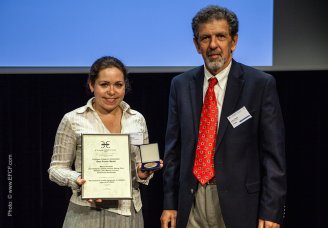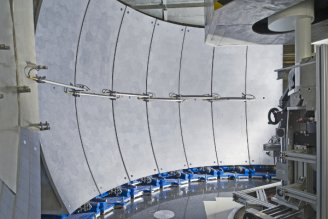Copyright 2012 neutronsources.org | All rights reserved. | Powered by FRM II | Imprint / Privacy Policy
Fuel Cells: Polymers, platinum and a poster prize
Date: 25/04/2016
Source: mlz-garching.de

Last summer Marina Khaneft got the poster prize at the 5th European Fuel Cell Forum (EFCF2015) for their contribution, now the associated detailed report to the catalytic layers of high-temperature polymer electrolyte fuel cells is published online: M. Khaneft et al., Structure and Proton Dynamics in catalytic layers of HT-PEFC, Fuel Cells 2016.
Also at the MLZ fuel cells are an important research area and are studied together with colleagues from the Institute of Energy and Climate Research (IEK-3) of the Forschungszentrum Jülich. Polymer electrolyte fuel cells convert hydrogen and oxygen in the heart of the fuel cell, the membrane-electrode unit, into electrical energy. The membrane of this unit is coated on both sides with the electrodes of nano-porous carbon and platinum particles. This type of fuel cell is very versatile, but has serious disadvantages: cooling and water management are complex and the catalyst is sensitive to carbon monoxide. These disadvantages are eliminated in the so-called high-temperature variant (HT-PEFC), which operates at temperatures of 160-180 °C.

The authors of the study examined in more detail the structures and proton diffusion using quasi-elastic neutron scattering (QENS) to find out how to improve the efficiency of the composition of the catalytic layers on the membranes. Analysing this problem the proton transfer in phosphoric acid, which is present in the electrode layer, and the connection to the platinum concentrations of the catalyst is essential. For its investigation QENS at the instrument SPHERES is an ideal method.
The proton diffusion, which determines the conductivity in the system, depends on the catalyst concentration. Phosphoric acid appears to be “caught” by the platinum particles. The results show, that one can examine details of the operation of fuel cells with neutron scattering, which are not accessible with other techniques, and therefore can promote the optimisation of the individual components of the fuel cell for a longer life and better efficiency.
Original publication:
M. Khaneft et al., Structure and Proton Dynamics in Catalytic Layer of HT‐PEFC, Fuel Cells 2016